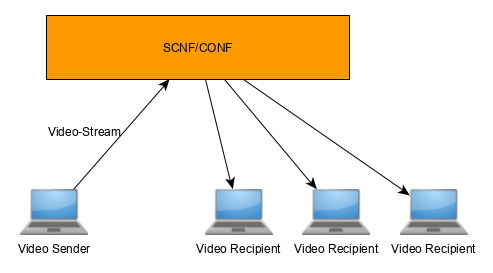Reference13r3:Concept Multi-Video-Conference
Description
The PBX conference object now supports multiple video streams. Not only one video stream of the current speaker, but video streams from all participating users.
Applies To
- innovaphone PBX from version 13r3
Requirements
- innovaphone PBX
- Firmware V13r3xx
- Endpoints supporting the multi-video signaling technology
Endpoints
In order to see multiple videos the endpoint must support the new multi-video signaling. Available endpoints are:
- innovaphone Softphone-App (version 13r3 or higher)
- innovaphone Phone-App (version 13r3 or higher) and a desk-phone
- innovaphone Web Access Client
Multi-Video Signaling
A multi-video conference starts as any other traditional conference by calling a conference object (See "How to configure a conference object" for mor information). An audio-only connection is established at the very beginning. A welcome message might be played to the new participant (if configured). After this initial call setup the calling endpoint is joined into the conference room. It now can hear all other participants and can speak to other participants.
To every participant the conference room provides information about all current participants. This participant information block contains information about:
- Display name
- Status flags (e.g. is-muted, is-speaking, is-sharing, wants-to-speak)
- Video stream information (contains information about available video streams of a participant)
After having the initial audio-only connection established, an endpoint with a video camera may establish additional video-send connections. These video-send signaling connections are independent from (but related to) the main connection (audio-only). Up to 3 video-send connections can be established with different quality/bandwidth profiles:
- LOW bandwidth video stream (bandwidth < 100 kbit/s)
- MEDIUM bandwidth video stream (bandwidth < 250 kbit/s)
- HIGH bandwidth video stream (bandwidth < 1000 kbit/s)
All these video streams are sent to the central conference. The central conference will broadcast these video streams to other participants on demand.
Other participants get information about the offered video streams and other participants can get these video streams by opening dedicated video-recv connections.
Bandwidth Consideration
Client side
As mentioned above, clients can send up to 3 upstreams, depending on which video stream was requested by the other endpoints. If we add up the bandwidths of the individual video streams, we get a maximum upstream bandwidth of about 1350 kbit/s. (1000kbit/s + 250 kbit/s + 100 kbit/s = 1350 kbit/s)
Calculating the downstream is a bit more difficult, as this depends on the view of the client.
- In the gallery view, web access can display up to 20 video streams of participants, which gives a downstream of about 5 Mbps (20 * 250 kbit/s = 5 Mbit/s).
- If the client has one participant in focus, we need to add one high-resolution video and 20 low-resolution videos. Combined, this results in a bandwidth consumption of 3 Mbps downstream (1000kbit/s + 20 *100kbit/s = 3Mbit/s).
SCNF/CONF side
The bandwidth consumption for the conference interface depends on the number of participants in the meeting and which view the clients use. We will use maximum values for our calculation, which is a mixture of all the possibilities. Note that this is a worst-case calculation and the bandwidth consumption will not be that high because participants tend to use the same view and focus on the same speaker.
Since each client can send up to 1350 kbit/s, we have to multiply this number by the number of subscribers to get the result of the required downstream bandwidth. With 20 subscribers, the worst-case downstream bandwidth is 27 Mbit/s (1350 kbit/s * 20 = 27 Mbit/s).
Since each client can receive up to 5 Mbit/s, you must multiply this by the number of subscribers. So, if there are 20 participants, the maximum upstream is 100 Mbit/s (5 Mbit/s * 20 = 100 Mbit/s).
